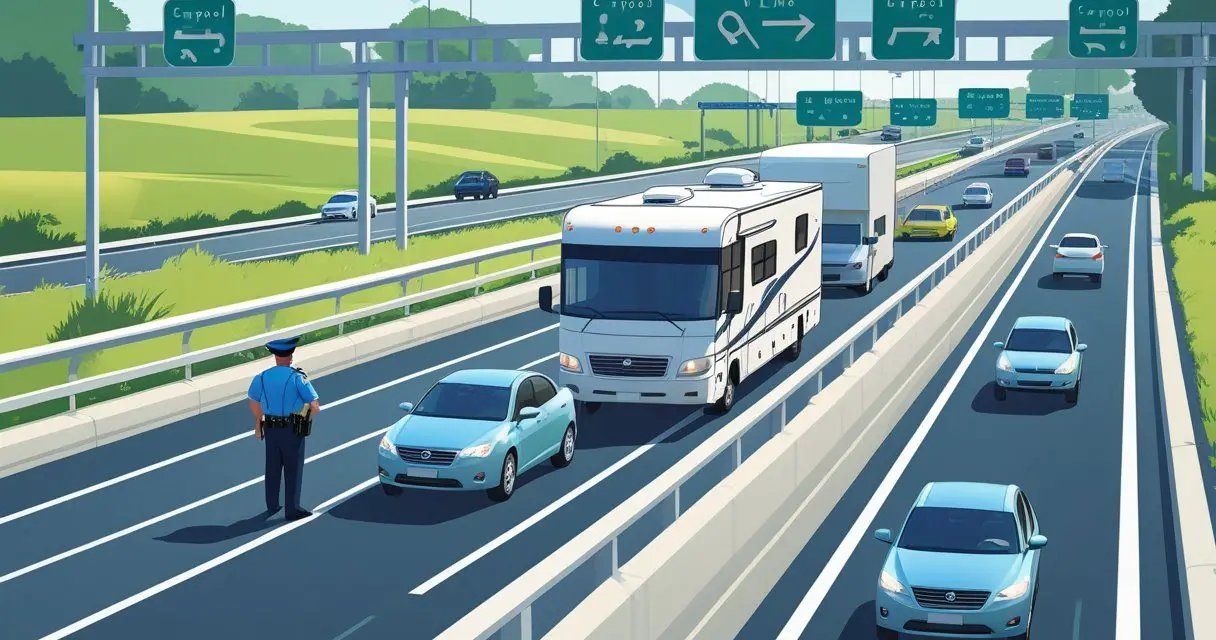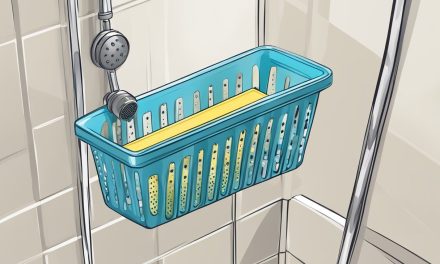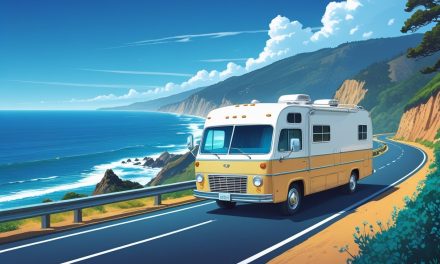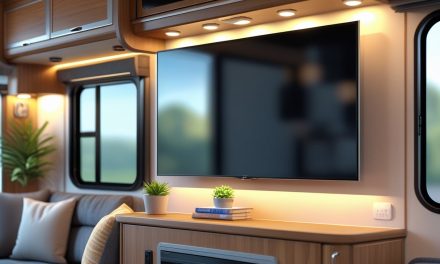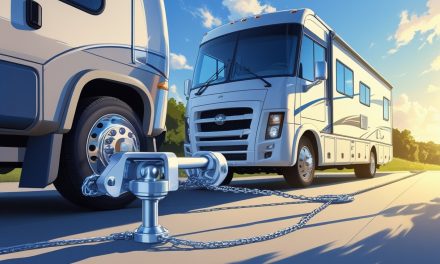Would you like to save this article?
Driving an RV on the highway often raises the question of whether you can use the carpool lane. You can drive an RV in the carpool lane if it meets the passenger requirements and local rules, but restrictions apply based on size, weight, and towing.
Knowing these details before your trip helps you avoid costly mistakes.
Not every state treats RVs the same way, and some have strict limits that keep larger motorhomes or towing setups out of the lane. Even when allowed, your RV must keep up with posted speeds to avoid slowing traffic.
Paying attention to signs and local laws ensures you stay compliant and safe.
Key Takeaways
- RVs can use carpool lanes if they meet passenger and vehicle rules
- Towing or exceeding weight and size limits usually blocks access
- Following posted laws prevents fines and keeps travel safe
Carpool Lane Basics for RVs
Carpool lanes, also called HOV lanes, have specific rules that affect whether your RV can use them. These rules focus on who qualifies, why the lanes exist, and how they differ from the rest of the highway.
What Is a Carpool Lane
A carpool lane, or High-Occupancy Vehicle (HOV) lane, is a lane set aside for vehicles carrying more than one person. The minimum is usually two people, but in some regions it can be three or more.
Signs along the highway mark these lanes with a diamond symbol (◇) and list the passenger requirement. Some HOV lanes only operate during peak hours, while others are enforced 24/7.
You must meet the posted rules to drive legally in these lanes. For RVs, this often means carrying the right number of passengers and following any size, weight, or towing restrictions.
Purpose and Benefits of HOV Lanes
HOV lanes exist to reduce traffic congestion and encourage ride-sharing. By moving more people in fewer vehicles, they help cut down on fuel use and lower emissions.
These lanes often allow for faster travel times during rush hour because they carry fewer vehicles than general lanes. This can make a noticeable difference on busy urban highways.
For RV drivers, the benefit is less about daily commuting and more about avoiding long delays on crowded roads. If your RV qualifies, you may save time and fuel while traveling through congested areas.
Key Differences Between Carpool and General Lanes
Carpool lanes have occupancy rules that general lanes do not. You cannot enter an HOV lane alone unless you drive a vehicle with special approval, such as some electric cars with permits.
Another difference is enforcement. Police monitor HOV lanes closely, and fines for violations can be steep. In California, for example, the penalty can reach several hundred dollars.
Carpool lanes may also have vehicle restrictions. Large or heavy RVs, or those towing trailers, are often excluded for safety reasons. General lanes do not carry these limits, so you must pay close attention to posted signs before merging into an HOV lane.
Regulations for RVs in Carpool Lanes
Rules for driving an RV in a carpool lane depend on where you are, how many people are inside, and the weight or size of your vehicle. You need to check both state laws and posted signs before entering an HOV lane to avoid fines or safety violations.
State-by-State Differences
Carpool lane laws vary across the United States. In California, the California Vehicle Code and CHP (California Highway Patrol) enforce strict limits.
Vehicles towing trailers cannot use HOV lanes, and large motorhomes must stay in the right lane unless passing. In Virginia, RVs may use HOV-3 lanes if three or more people are inside and the vehicle weighs less than 10,000 pounds.
Florida and Colorado also allow RVs in carpool lanes if they meet the minimum occupancy rule, usually two or more people. Some states, such as Connecticut, prohibit RVs from using HOV lanes entirely.
Always confirm local rules through the state’s Department of Transportation before traveling.
| State | Allowed in HOV Lane | Notes |
|---|---|---|
| California | Yes, if not towing | Must meet occupancy rule |
| Virginia | Yes | Weight under 10,000 lbs |
| Connecticut | No | RVs prohibited |
| Florida | Yes | Two or more occupants required |
Occupancy Requirements for RVs
Carpool lanes exist to reduce traffic by encouraging shared rides. Most states require two or more occupants (HOV-2), while some urban areas use HOV-3.
You must count only people seated inside the motorhome. Pets and mannequins do not qualify.
Law enforcement, including the CHP, checks for visible occupants during enforcement periods. If you travel alone in an RV, you cannot use the carpool lane even if the vehicle is large.
Violating occupancy rules can result in fines that often exceed $400 in states like California. Always look for posted signs showing the current HOV requirements and hours of operation.
Vehicle Size and Classification Rules
RVs fall under different classifications depending on their gross vehicle weight (GVW) and whether they tow another vehicle. States often restrict long or heavy RVs from using left or HOV lanes due to safety and speed differences.
In California, vehicles towing trailers must stay in the right lane. The CHP enforces this to prevent slow-moving traffic in faster lanes.
Smaller Class B campervans that keep up with traffic may be permitted in carpool lanes if they meet occupancy rules. Check your RV’s registration for its official classification.
Knowing whether your vehicle is considered a passenger vehicle or a commercial-type motorhome helps determine if it qualifies for HOV use.
Towing and Trailers: Critical Restrictions
When you tow a trailer with your RV, your access to the carpool lane changes. State laws often limit where towing vehicles can drive, and these limits exist to maintain safety and traffic flow.
Rules for RVs Towing Trailers
If you tow a trailer, you generally cannot use the carpool (HOV) lane. In California, the Vehicle Code and DMV Handbook state that vehicles towing trailers must stay in the right-hand lanes.
This rule applies even if you have multiple passengers. The reason is tied to the 55 MPH towing speed limit.
Since vehicles towing trailers must travel slower, they can disrupt faster-moving HOV traffic. Law enforcement monitors these lanes closely, and violations can result in fines.
Other states follow similar restrictions. For example, most interstate highways prohibit any vehicle towing a trailer from driving in the left or HOV lanes, except when turning or avoiding obstacles.
Always check posted signs because some areas may have additional weight or length limits.
| Restriction | Applies To | Typical Rule |
|---|---|---|
| Towing a trailer | All RV types | No HOV lane use |
| Speed limit | Towing vehicles | 55 MPH (CA) |
| Lane use | Multi-lane highways | Right or middle lanes only |
Impact on Lane Access and Safety
Towing changes how your vehicle handles. The added weight increases stopping distance and reduces acceleration.
These factors make it unsafe to drive in faster lanes, including carpool lanes, where speeds often exceed 65 MPH. The California Highway Patrol (CHP) enforces these limits to prevent collisions and maintain lane consistency.
A slower, heavier vehicle in the HOV lane can cause sudden braking or lane changes by other drivers. Using the correct lane improves safety for everyone.
You reduce the risk of sway, jackknifing, or losing control on curves. Staying in slower lanes also makes it easier to exit or pull over if your trailer needs attention.
If you’re unsure about your route, plan ahead using official DOT or CHP websites for lane and towing restrictions.
Special Cases for Small Trailers
Some smaller camper trailers or tow dollies may seem light enough for the carpool lane, but the rules rarely make exceptions. Even a compact trailer triggers the same towing restrictions under the California Vehicle Code.
However, in other states, enforcement may vary. A few jurisdictions allow light-duty tow vehicles under certain weight limits, but these cases are uncommon.
Always verify the gross combined weight rating (GCWR) of your vehicle and trailer before assuming access. If your RV is a Class B campervan without a tow load, you may qualify for HOV use when carrying the required number of passengers.
Once you attach any trailer, though, you lose that eligibility. Keep your focus on compliance and safety.
Following posted signs and understanding your vehicle’s classification will help you avoid fines and unsafe driving conditions.
Travel Time, Speed, and Lane Usage Considerations
Driving an RV in busy traffic requires planning and awareness of speed and lane rules. You need to know how congestion, towing limits, and lane restrictions affect your travel time and where you can safely drive.
Peak Travel Times and Congestion
Traffic congestion increases sharply during morning and evening rush hours, especially near major cities. RVs take longer to accelerate and stop, so heavy traffic can make driving more stressful and less fuel-efficient.
If possible, plan your trips outside peak travel times—typically 7–9 a.m. and 4–7 p.m. Local traffic apps or state DOT websites can help you track congestion and choose alternate routes.
Because RVs are larger, merging and lane changes take more space and time. Staying in the right or middle lanes during heavy traffic helps you maintain a steady pace and reduces sudden braking.
When towing, expect slower progress through congested areas. The extra weight and length make it harder to maneuver quickly, so allow more distance between vehicles and avoid frequent lane changes.
Speed Limits for RVs and Towing
Speed limits for RVs vary by state, but many set lower limits for vehicles that tow. For example, California requires a maximum of 55 mph for any vehicle towing a trailer, even if the posted limit is higher.
You should always follow the towing speed limit, even when traffic moves faster. Exceeding it can increase stopping distance and cause sway or tire overheating.
| Vehicle Type | Typical Max Speed | Notes |
|---|---|---|
| RV (not towing) | 65–70 mph | Depends on state and road type |
| RV towing trailer | 55 mph | Common towing limit in many states |
| Heavy Class A motorhome | 60–65 mph | May vary by weight and size |
Use the right lane or middle lane when driving slower than general traffic. This keeps faster vehicles from tailgating or passing unsafely.
Lane Restrictions for Large Vehicles
Some highways restrict large vehicles, including RVs, from using the far-left or “fast” lane. These rules improve safety and traffic flow by keeping slower, heavier vehicles out of high-speed lanes.
In California and other states, RVs over 10,000 pounds or towing must stay in the right two lanes on multi-lane highways. Signs posted along the road often indicate these restrictions.
If your RV is wide or tall, stay alert for lane width changes, especially in construction zones. Narrow lanes can make it difficult to maintain safe clearance from other vehicles.
Following lane restrictions helps prevent fines and reduces accident risk. It also makes your trip smoother by keeping your RV in lanes designed for its size and speed.
Exceptions and Exemptions
Some RVs can legally use the carpool lane under limited conditions. These exceptions depend on whether your vehicle qualifies as a clean air vehicle or if it’s being towed, which affects how the law applies to you.
Clean Air Vehicles and RVs
Certain clean air vehicles can use the HOV lane even with only one occupant. California and several other states issue special decals or license plates for qualifying electric and hybrid vehicles.
These stickers allow solo drivers to use the carpool lane during normal hours. However, large RVs and motorhomes rarely qualify for this exemption.
Most clean air programs apply to passenger cars or light-duty trucks, not heavy vehicles that exceed weight or emissions limits. In California, the clean air decal program is set to expire on September 30, 2025, unless extended by new legislation.
After that date, single-occupant access for clean air vehicles may end. Always verify the current status through your state’s Department of Motor Vehicles before relying on this exemption.
| Vehicle Type | Eligible for Clean Air Decal | HOV Access Allowed Solo |
|---|---|---|
| Electric car | Yes | Yes |
| Plug-in hybrid | Sometimes | Yes |
| Large RV or motorhome | Rarely | No |
Motorhome Versus Towed RV Rules
If you drive a motorhome without towing anything and meet the passenger requirement, you may be allowed in the carpool lane. Rules vary by state, but California law is clear—no vehicle subject to a 55 MPH towing speed limit can use the HOV lane.
Once you attach a trailer, car, or boat, your RV becomes a towing vehicle, which disqualifies it from carpool lane use regardless of how many people are inside. The restriction exists for safety reasons since towing reduces braking ability and lane stability.
Even if your motorhome is small, always check posted signs for weight or size limits. Some HOV lanes restrict vehicles over 10,000 pounds or those too wide for safe travel.
Legal Compliance and Enforcement
Driving an RV in a carpool lane requires you to follow both state and local traffic laws. Failing to meet occupancy, weight, or towing restrictions can lead to fines and enforcement actions under the California Vehicle Code and similar rules in other states.
Citations and Penalties for Violations
If you drive in a carpool lane without meeting the requirements, you can receive a citation. In California, fines often range from $400 to $500, depending on the county and violation details.
These penalties are issued under sections of the California Vehicle Code (CVC) that cover HOV lane misuse. The violation may also add points to your driving record, which can affect insurance rates.
Common reasons for citations include:
- Driving solo in an HOV lane
- Towing a trailer or vehicle
- Exceeding posted weight or size limits
Repeat offenses can lead to higher fines or court appearances. Paying attention to posted signs and lane markings helps you avoid these penalties.
Role of Law Enforcement and CHP
The California Highway Patrol (CHP) and other state agencies monitor carpool lanes using patrols, cameras, and roadside sensors. Officers look for vehicles with too few occupants or those towing trailers, which are not allowed in many HOV lanes.
CHP officers often patrol during peak commute hours when misuse is most common. They can stop you directly or issue a mailed citation based on camera evidence.
Law enforcement uses these methods to keep traffic flowing safely and to ensure that carpool lanes serve their intended purpose—moving more people efficiently. You should expect consistent enforcement, especially in urban areas such as Los Angeles, San Francisco, and San Diego.
How to Check Local Laws
Carpool lane rules vary by state and even by highway segment. Before driving your RV, check your state Department of Transportation (DOT) or CHP website for current HOV regulations.
Look for details about:
- Minimum passenger requirements
- Weight or size restrictions
- Towing prohibitions
- Special access for clean-air or low-emission vehicles
You can also review the California Vehicle Code Section 21655.5 for state-specific guidance.
Local signage on highways provides the most immediate information. Always read posted instructions before entering a carpool lane.

